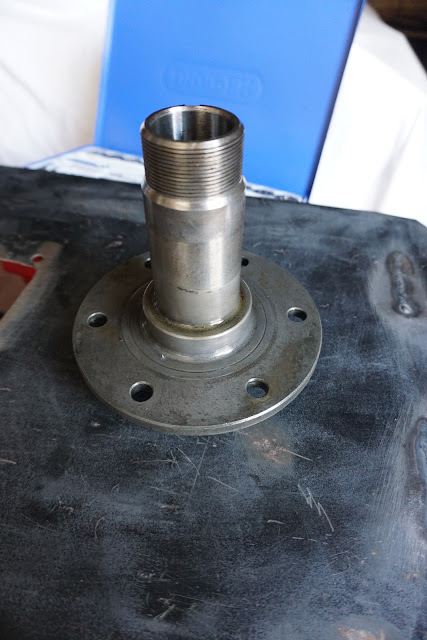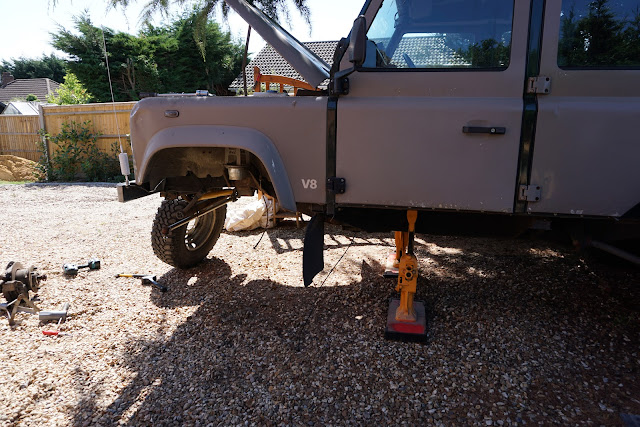Firstly installing a trim to the rear tub that holds the seal in place. The trim came from YRM, nice stainless item. The only snag I had was that the trim is designed to be installed on to a flat tub with a build up of just carpet or rubber mat, so as per my build up which is sound deadening mat and checker plate. This has meant the trim is at an angle, but it looks and works fine so all good.
The other job was to install a locking latch into the battery box cover. This latch.
So the cover was cut to be able to get in and out of the hole, as it would no longer be able to slide in and out as before. Then tabs were welded onto the back section to prevent the rear from lifting. A hole cut for the latch.
At this point the main panel is read for painting, which will take place a bit latter when I have a few parts to do, photos of the finished item will be included in part two. Then the seat box needed to be modify to ensure the latch engaged snugly and it didn’t flap around. For this I welded two section of angle together to get the right dimensions, and riveted it into place.
As
part of these works I discovered (may have been around ages, who knew) (edit:
in fact, I have already tried a rust remover gel when I first started, with somewhat
poor results) a product that claims to be a rust remover. So I will be testing
these as part of this. Firstly the branded version - Evapo-Rust
And the Frost home brand rust remover.
So this rust removing
liquid, if you believe the hype removes rust, and the longer you leave items
soaking the more hard-core the rust can be - I’m sceptical and best. And at
this point I would say this stuff it REALLY expensive. So £25 will get you
3.75L (US Gallon) or 5L of the home brand. And when you think about what you
need it to do - submerge the whole item - that’s a lot! There is a Gel, which
will “stick” to the part to do the same things, some say you can add water, and
they all say they are re-useable. But I will touch on these at the end. For
this I will be testing the products on the callipers - control subject. One
side per product. And the stub axles, as these are chromed items, that if I
wire brushed them, wouldn’t fare so well, plus a few random bits. The willing
test subjects:
Here we go…..
After 24hrs.
I must say, I’m impressed. It's
safely remove a vast majority of the rust. This would have been a hard, grim,
noisy job on the grinder. Which you also could not have done on something sensitive.
However, it’s not without fault:
It’s not perfect. Some things I put in for another 24hrs, and then I still got the wire brush out. Another thing to consider is that the chromed stuff come out dull, dusky coloured. It’s odd to describe, almost like it was sandblasted, It wasn’t chrome any more, clean but not shiny. Not sure if this is better or worse. But it did mostly remove the rust, which was impressive considering how little effort it took. And with the other points - adding water - this meant the liquid lost its rust removing capability a lot quicker, which makes sense. Can re-use it for multiple jobs - I found after a good job, something really rusty, it had little to no effect, and if you left it in there for an extended time the parts were left covered with a yellow paste, which was a pain to remove. Another thing to consider is that the part needs to be fully submerged, which rules our really large parts, unless you’re willing to spend a lot of money on buying the remover. I did get a 25l tub of the Frost branded stuff for £100, which was the best value, but really it wouldn’t take a huge part as the bigger the part the bigger the bucket to put it in is. Also the gel which is used to stick to parts that can’t be submerged, was very ineffective, and also hard to apply and take off. Its form is that of a very dense slime, and for £10 the bottle is tiny. I’d suggest if you need this then get out the grinder. The instructions do state that for larger items cloths should be soaked and left on the part, but I didn’t try this method.
In regards to the Branded and own
brand battle, both seem to do the job as well as each other, so I’d go back to
the Frost stuff each time, as it’s cheaper.
So in summary - great product.
But it’s only really better than an angle grinder with a wire brush when - the
part is sensitive (but even then see above), or it’s a nightmare shape that is
not wire brushable – or you don’t want to annoy the neighbours with the grinder
use. But I guess this will depend on your budget, and preference.

























































